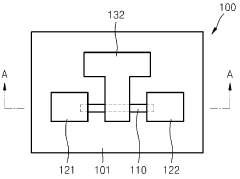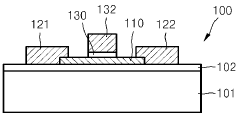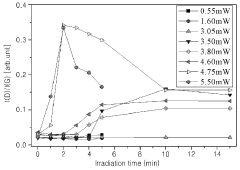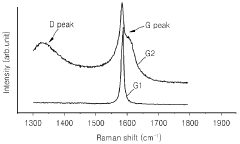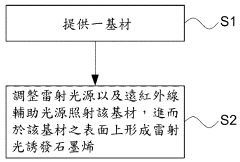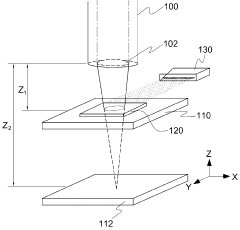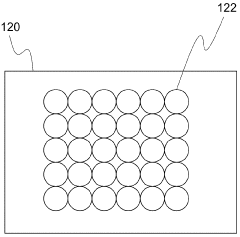Flash healing of laser-induced graphene
MAY 13, 20259 MIN READ
Generate Your Research Report Instantly with AI Agent
Patsnap Eureka helps you evaluate technical feasibility & market potential.
LIG Flash Healing Background and Objectives
Laser-induced graphene (LIG) has emerged as a groundbreaking material in the field of advanced electronics and energy storage. The flash healing of LIG represents a significant technological advancement that addresses the challenges of scalability and durability in LIG-based devices. This process involves the rapid repair of structural defects and the restoration of electrical properties in LIG through brief, intense light exposure. The evolution of this technology can be traced back to the initial discovery of graphene and subsequent developments in graphene synthesis methods. As researchers sought more efficient and cost-effective ways to produce graphene-based materials, the laser-induced graphene technique emerged as a promising approach. The flash healing process builds upon this foundation, offering a solution to enhance the performance and longevity of LIG structures. The primary objective of flash healing technology is to develop a rapid, energy-efficient method for repairing and optimizing LIG materials, thereby improving their electrical conductivity, mechanical strength, and overall stability. This technology aims to overcome the limitations of traditional graphene production methods, which often struggle with issues of scalability, consistency, and defect management. By enabling the quick and effective healing of LIG, this approach has the potential to revolutionize the manufacturing of graphene-based devices, opening up new possibilities in flexible electronics, energy storage systems, and sensors. The development of flash healing techniques for LIG is driven by the growing demand for high-performance, sustainable materials in various technological applications. As industries continue to push the boundaries of miniaturization and energy efficiency, the need for advanced materials that can meet these demands becomes increasingly critical. The flash healing of LIG represents a significant step towards realizing the full potential of graphene-based technologies, offering a pathway to create more robust, efficient, and versatile electronic components and energy storage devices. This technology not only addresses current challenges in graphene production and application but also paves the way for future innovations in material science and nanotechnology.
Market Demand Analysis for Self-Healing Materials
The market for self-healing materials, particularly those incorporating laser-induced graphene (LIG), is experiencing significant growth and attracting considerable attention across various industries. This emerging technology offers promising solutions to enhance the durability and longevity of materials, addressing the increasing demand for sustainable and resilient products. The self-healing materials market is projected to reach $4.1 billion by 2025, with a compound annual growth rate (CAGR) of 27.4% from 2020 to 2025. The flash healing of LIG represents a subset of this market, with potential applications in electronics, aerospace, automotive, and energy sectors.
In the electronics industry, there is a growing need for self-healing materials to improve the reliability and lifespan of flexible and wearable devices. The global flexible electronics market is expected to reach $40.37 billion by 2023, with a CAGR of 11.0% from 2017 to 2023. Flash-healed LIG could play a crucial role in developing durable and self-repairing components for these devices, addressing issues such as mechanical stress and environmental degradation.
The aerospace and automotive industries are also showing increased interest in self-healing materials to enhance the safety and performance of their products. The global market for advanced materials in the aerospace industry is projected to reach $5.9 billion by 2026, growing at a CAGR of 6.5% from 2021 to 2026. Flash-healed LIG could potentially be used in developing lightweight, self-repairing composites for aircraft and automotive structures, reducing maintenance costs and improving fuel efficiency.
In the energy sector, the demand for self-healing materials is driven by the need for more durable and efficient energy storage and conversion devices. The global energy storage market is expected to grow from $2.9 billion in 2020 to $12.1 billion by 2025, at a CAGR of 33.1%. Flash-healed LIG could find applications in developing self-repairing electrodes for batteries and supercapacitors, potentially extending their lifespan and improving overall performance.
The increasing focus on sustainability and circular economy principles is also driving the demand for self-healing materials. As industries seek to reduce waste and extend product lifecycles, technologies like flash-healed LIG offer promising solutions to minimize material consumption and enhance product durability. This aligns with global initiatives such as the European Union's Circular Economy Action Plan, which aims to promote sustainable product design and reduce waste generation.
In the electronics industry, there is a growing need for self-healing materials to improve the reliability and lifespan of flexible and wearable devices. The global flexible electronics market is expected to reach $40.37 billion by 2023, with a CAGR of 11.0% from 2017 to 2023. Flash-healed LIG could play a crucial role in developing durable and self-repairing components for these devices, addressing issues such as mechanical stress and environmental degradation.
The aerospace and automotive industries are also showing increased interest in self-healing materials to enhance the safety and performance of their products. The global market for advanced materials in the aerospace industry is projected to reach $5.9 billion by 2026, growing at a CAGR of 6.5% from 2021 to 2026. Flash-healed LIG could potentially be used in developing lightweight, self-repairing composites for aircraft and automotive structures, reducing maintenance costs and improving fuel efficiency.
In the energy sector, the demand for self-healing materials is driven by the need for more durable and efficient energy storage and conversion devices. The global energy storage market is expected to grow from $2.9 billion in 2020 to $12.1 billion by 2025, at a CAGR of 33.1%. Flash-healed LIG could find applications in developing self-repairing electrodes for batteries and supercapacitors, potentially extending their lifespan and improving overall performance.
The increasing focus on sustainability and circular economy principles is also driving the demand for self-healing materials. As industries seek to reduce waste and extend product lifecycles, technologies like flash-healed LIG offer promising solutions to minimize material consumption and enhance product durability. This aligns with global initiatives such as the European Union's Circular Economy Action Plan, which aims to promote sustainable product design and reduce waste generation.
Current State and Challenges in LIG Flash Healing
Laser-induced graphene (LIG) has emerged as a promising material for various applications due to its unique properties and facile production method. However, the flash healing of LIG presents both opportunities and challenges in the current state of research and development. The process of flash healing involves the rapid repair or modification of LIG structures using intense light pulses, typically from lasers or other high-energy sources. This technique has shown potential for enhancing the properties and functionality of LIG materials, but it also faces several technical hurdles that need to be addressed.
One of the primary challenges in LIG flash healing is achieving uniform and controlled healing across the entire material surface. The heterogeneous nature of LIG, with its porous structure and varying thickness, can lead to inconsistent healing results. Researchers are working on optimizing the flash healing parameters, such as pulse duration, energy density, and wavelength, to ensure more homogeneous healing outcomes. Additionally, the scalability of the flash healing process for large-area LIG samples remains a significant challenge, as maintaining uniform energy distribution over larger surfaces becomes increasingly difficult.
Another critical issue is the potential for thermal damage or degradation of the LIG structure during the flash healing process. The high-energy pulses used for healing can sometimes lead to unwanted structural changes or even ablation of the material. Striking the right balance between effective healing and preserving the desired LIG properties is a delicate task that requires precise control over the healing conditions. Researchers are exploring various approaches to mitigate this issue, including the use of protective coatings or controlled atmospheres during the healing process.
The integration of flash healing into existing LIG production processes also presents challenges. Current LIG fabrication methods, such as direct laser writing or CO2 laser irradiation of polyimide films, may need to be adapted to incorporate the flash healing step seamlessly. This integration requires careful consideration of factors such as production speed, cost-effectiveness, and compatibility with different substrate materials.
Furthermore, the long-term stability and reliability of flash-healed LIG structures are areas of ongoing investigation. While flash healing can improve certain properties of LIG, such as electrical conductivity or mechanical strength, the durability of these enhancements under various environmental conditions and over extended periods needs to be thoroughly evaluated. Researchers are conducting extensive studies to assess the aging behavior and performance retention of flash-healed LIG materials in different applications.
Despite these challenges, the field of LIG flash healing is rapidly evolving, with researchers and industry players actively working on innovative solutions. Advancements in laser technology, such as the development of more precise and controllable light sources, are contributing to improved healing outcomes. Additionally, the combination of flash healing with other post-processing techniques, such as chemical treatments or thermal annealing, is being explored to further enhance the properties and functionality of LIG materials.
One of the primary challenges in LIG flash healing is achieving uniform and controlled healing across the entire material surface. The heterogeneous nature of LIG, with its porous structure and varying thickness, can lead to inconsistent healing results. Researchers are working on optimizing the flash healing parameters, such as pulse duration, energy density, and wavelength, to ensure more homogeneous healing outcomes. Additionally, the scalability of the flash healing process for large-area LIG samples remains a significant challenge, as maintaining uniform energy distribution over larger surfaces becomes increasingly difficult.
Another critical issue is the potential for thermal damage or degradation of the LIG structure during the flash healing process. The high-energy pulses used for healing can sometimes lead to unwanted structural changes or even ablation of the material. Striking the right balance between effective healing and preserving the desired LIG properties is a delicate task that requires precise control over the healing conditions. Researchers are exploring various approaches to mitigate this issue, including the use of protective coatings or controlled atmospheres during the healing process.
The integration of flash healing into existing LIG production processes also presents challenges. Current LIG fabrication methods, such as direct laser writing or CO2 laser irradiation of polyimide films, may need to be adapted to incorporate the flash healing step seamlessly. This integration requires careful consideration of factors such as production speed, cost-effectiveness, and compatibility with different substrate materials.
Furthermore, the long-term stability and reliability of flash-healed LIG structures are areas of ongoing investigation. While flash healing can improve certain properties of LIG, such as electrical conductivity or mechanical strength, the durability of these enhancements under various environmental conditions and over extended periods needs to be thoroughly evaluated. Researchers are conducting extensive studies to assess the aging behavior and performance retention of flash-healed LIG materials in different applications.
Despite these challenges, the field of LIG flash healing is rapidly evolving, with researchers and industry players actively working on innovative solutions. Advancements in laser technology, such as the development of more precise and controllable light sources, are contributing to improved healing outcomes. Additionally, the combination of flash healing with other post-processing techniques, such as chemical treatments or thermal annealing, is being explored to further enhance the properties and functionality of LIG materials.
Existing Flash Healing Techniques for LIG
01 Laser-induced graphene formation and properties
Laser irradiation is used to convert various carbon-containing precursors into graphene. This process creates porous, conductive graphene structures with unique properties. The laser-induced graphene can be tailored for specific applications by adjusting laser parameters and precursor materials.- Laser-induced graphene formation and properties: Laser-induced graphene (LIG) is created by direct laser writing on various carbon-containing substrates. This process produces porous graphene structures with unique electrical, thermal, and mechanical properties. The formation of LIG can be controlled by adjusting laser parameters, substrate composition, and environmental conditions, allowing for tailored graphene structures suitable for various applications.
- Self-healing mechanisms in laser-induced graphene: LIG exhibits self-healing properties due to its porous structure and high surface area. When damaged, the graphene network can reorganize and reform bonds, restoring electrical conductivity and mechanical integrity. This self-healing capability can be enhanced by incorporating additional materials or by applying external stimuli such as heat or electrical current.
- Applications of self-healing laser-induced graphene: Self-healing LIG finds applications in various fields, including flexible electronics, sensors, energy storage devices, and biomedical implants. The ability to recover from damage extends the lifespan and reliability of these devices, particularly in wearable and implantable technologies where mechanical stress is common.
- Composite materials for enhanced healing in LIG: Incorporating additional materials into LIG can enhance its self-healing properties. Polymers, nanoparticles, or other functional materials can be integrated during the laser-induced graphene formation process or added post-fabrication. These composites can provide improved mechanical strength, faster healing rates, or additional functionalities such as antimicrobial properties.
- Characterization and optimization of healing in LIG: Various techniques are employed to characterize and optimize the healing process in LIG. These include microscopy, spectroscopy, and electrical measurements to assess the extent and efficiency of healing. Optimization involves adjusting laser parameters, environmental conditions, and material compositions to achieve rapid and complete restoration of graphene properties after damage.
02 Self-healing capabilities of laser-induced graphene
Laser-induced graphene exhibits self-healing properties, allowing it to recover from damage. This feature enhances the durability and longevity of graphene-based devices and structures. The self-healing mechanism involves the reformation of carbon bonds under certain conditions.Expand Specific Solutions03 Applications in flexible electronics and sensors
Laser-induced graphene is utilized in flexible and wearable electronics, as well as in sensor applications. Its conductivity, flexibility, and ability to be patterned directly on various substrates make it suitable for creating stretchable circuits, electrodes, and sensing elements.Expand Specific Solutions04 Energy storage and conversion applications
The porous structure and high surface area of laser-induced graphene make it suitable for energy storage and conversion devices. It is used in supercapacitors, batteries, and fuel cells to improve performance and efficiency.Expand Specific Solutions05 Surface modification and functionalization
Laser-induced graphene can be further modified or functionalized to enhance its properties or add new functionalities. This includes doping with heteroatoms, decorating with nanoparticles, or grafting functional groups to tailor the graphene for specific applications or improve its healing capabilities.Expand Specific Solutions
Key Players in LIG and Self-Healing Materials
The flash healing of laser-induced graphene technology is in its early development stage, with significant potential for growth. The market size is expanding as applications in flexible electronics, sensors, and energy storage devices emerge. While the technology is promising, it is still evolving, with varying levels of maturity across different companies. Key players like William Marsh Rice University, Samsung Electronics Co., Ltd., and National University of Singapore are at the forefront of research and development. Other institutions such as Zhejiang University, Shandong University, and Beihang University are also making notable contributions. The competitive landscape is characterized by a mix of academic institutions, tech giants, and specialized companies, each focusing on different aspects of the technology's development and application.
William Marsh Rice University
Technical Solution: Rice University has developed a groundbreaking technique for flash healing of laser-induced graphene (LIG). Their method involves using a high-intensity xenon lamp to rapidly heat and cool LIG, resulting in improved electrical conductivity and mechanical properties. The process takes only milliseconds and can be applied to various substrates, including polymers and wood. This technique allows for the creation of flexible, conductive patterns on diverse materials, opening up possibilities for wearable electronics and sensors.
Strengths: Rapid processing time, versatility in substrate selection, and improved material properties. Weaknesses: Potential limitations in scalability for large-area production and energy consumption of the flash healing process.
Samsung Electronics Co., Ltd.
Technical Solution: Samsung has developed a proprietary flash healing technique for laser-induced graphene that focuses on enhancing the performance of flexible electronic devices. Their method utilizes a combination of laser patterning and rapid thermal annealing to create highly conductive graphene patterns on flexible substrates. The process involves precise control of laser parameters and a subsequent short-duration, high-temperature treatment to optimize the graphene structure. This technique enables the production of bendable, stretchable electronic components with improved durability and conductivity.
Strengths: Integration with existing flexible electronics manufacturing processes and enhanced device performance. Weaknesses: Potential challenges in maintaining consistent quality across large-scale production.
Core Innovations in LIG Flash Healing Mechanisms
Method of healing defect of graphene using laser beam and manufacturing electronic device using the same
PatentInactiveKR1020110042952A
Innovation
- In-situ detection of graphene defects using Raman spectroscopy, enabling real-time monitoring and targeted healing.
- Precise control of laser parameters (wavelength, power, and irradiation time) for effective defect healing in graphene nano ribbons.
- Integration of defect detection and healing processes into a single method, streamlining the production of high-quality graphene for electronic devices.
Method for preparing laser-induced graphene
PatentActiveTW202227360A
Innovation
- Combining laser light source with far-infrared auxiliary light source for graphene preparation.
- Using far-infrared auxiliary light to improve defect and electrical properties of laser-induced graphene.
- Developing a novel two-step irradiation process for enhanced graphene production.
Environmental Impact of LIG Flash Healing Processes
The environmental impact of laser-induced graphene (LIG) flash healing processes is an important consideration as this technology advances. LIG production itself is generally considered environmentally friendly due to its one-step, solvent-free nature. However, the flash healing process introduces additional energy consumption and potential emissions that warrant careful examination.
The primary environmental concern with LIG flash healing is energy consumption. The process typically involves high-intensity light pulses or electrical currents, which require significant power input. This energy demand could contribute to increased carbon emissions if sourced from non-renewable energy. However, the rapid nature of flash healing (often completed in milliseconds) may offset some of these concerns compared to traditional, more time-consuming healing methods.
Another aspect to consider is the potential release of volatile organic compounds (VOCs) during the flash healing process. As the LIG structure is rapidly heated, there may be off-gassing of residual compounds or breakdown products. While these emissions are likely minimal due to the brief duration of the process, their cumulative effect in large-scale applications should be studied.
The use of additional materials in the flash healing process, such as protective coatings or conductive additives, may also have environmental implications. These materials could introduce new waste streams or complicate the end-of-life recycling of LIG-based products. However, if flash healing extends the lifespan of LIG devices, it could reduce overall material consumption and waste generation.
Water usage in LIG flash healing is generally minimal, which is a positive environmental aspect compared to some traditional manufacturing processes. Additionally, the localized nature of the healing process minimizes the need for large-scale industrial facilities, potentially reducing land use and associated ecosystem disruption.
The scalability of LIG flash healing processes may influence their overall environmental impact. As the technology moves from laboratory to industrial scales, efficiency improvements and optimized energy management could mitigate some environmental concerns. Furthermore, the potential for integration with renewable energy sources could significantly reduce the carbon footprint of this process.
In conclusion, while LIG flash healing shows promise as a relatively eco-friendly manufacturing technique, a comprehensive life cycle assessment is necessary to fully understand its environmental implications. Future research should focus on optimizing energy efficiency, minimizing emissions, and exploring sustainable material options to ensure that the environmental benefits of this innovative technology are maximized.
The primary environmental concern with LIG flash healing is energy consumption. The process typically involves high-intensity light pulses or electrical currents, which require significant power input. This energy demand could contribute to increased carbon emissions if sourced from non-renewable energy. However, the rapid nature of flash healing (often completed in milliseconds) may offset some of these concerns compared to traditional, more time-consuming healing methods.
Another aspect to consider is the potential release of volatile organic compounds (VOCs) during the flash healing process. As the LIG structure is rapidly heated, there may be off-gassing of residual compounds or breakdown products. While these emissions are likely minimal due to the brief duration of the process, their cumulative effect in large-scale applications should be studied.
The use of additional materials in the flash healing process, such as protective coatings or conductive additives, may also have environmental implications. These materials could introduce new waste streams or complicate the end-of-life recycling of LIG-based products. However, if flash healing extends the lifespan of LIG devices, it could reduce overall material consumption and waste generation.
Water usage in LIG flash healing is generally minimal, which is a positive environmental aspect compared to some traditional manufacturing processes. Additionally, the localized nature of the healing process minimizes the need for large-scale industrial facilities, potentially reducing land use and associated ecosystem disruption.
The scalability of LIG flash healing processes may influence their overall environmental impact. As the technology moves from laboratory to industrial scales, efficiency improvements and optimized energy management could mitigate some environmental concerns. Furthermore, the potential for integration with renewable energy sources could significantly reduce the carbon footprint of this process.
In conclusion, while LIG flash healing shows promise as a relatively eco-friendly manufacturing technique, a comprehensive life cycle assessment is necessary to fully understand its environmental implications. Future research should focus on optimizing energy efficiency, minimizing emissions, and exploring sustainable material options to ensure that the environmental benefits of this innovative technology are maximized.
Scalability and Industrial Applications of LIG Flash Healing
The scalability and industrial applications of laser-induced graphene (LIG) flash healing represent a significant frontier in advanced materials science and manufacturing. As LIG technology continues to evolve, its potential for large-scale production and diverse industrial uses becomes increasingly apparent. The flash healing process, which rapidly repairs and restores LIG structures, offers a unique advantage in terms of durability and longevity of LIG-based devices and components.
From a scalability perspective, LIG flash healing shows promising potential for integration into high-volume manufacturing processes. The rapid nature of the healing process, often occurring within seconds, aligns well with the demands of industrial production lines. This speed factor could significantly reduce downtime and increase overall production efficiency in LIG-based product manufacturing. However, challenges remain in scaling up the flash healing process to accommodate larger surface areas and more complex geometries typical in industrial applications.
In terms of industrial applications, LIG flash healing opens up new possibilities across various sectors. In the electronics industry, for instance, this technology could be applied to self-healing circuits and flexible electronics, enhancing the lifespan and reliability of devices. The automotive sector might benefit from LIG flash healing in the development of durable, lightweight components with self-repairing capabilities. In aerospace, where material integrity is crucial, this technology could contribute to the creation of smart structures capable of autonomous repair.
The energy sector presents another promising area for LIG flash healing applications. Self-healing electrodes in batteries and supercapacitors could significantly extend the life and performance of energy storage devices. In the field of environmental technology, LIG-based sensors with flash healing capabilities could offer more robust and long-lasting solutions for monitoring air and water quality.
However, to fully realize the industrial potential of LIG flash healing, several challenges need to be addressed. These include optimizing the energy requirements for the healing process, ensuring consistency in healing quality across large areas, and developing methods to trigger healing in complex, multi-layered structures. Additionally, the integration of LIG flash healing into existing manufacturing processes and quality control systems presents logistical and technical hurdles that need to be overcome.
As research in this field progresses, we can expect to see advancements in the scalability of LIG flash healing, potentially leading to new manufacturing paradigms that incorporate self-healing materials as a standard feature. This could revolutionize product design and lifecycle management across multiple industries, offering enhanced durability, reduced maintenance needs, and improved sustainability.
From a scalability perspective, LIG flash healing shows promising potential for integration into high-volume manufacturing processes. The rapid nature of the healing process, often occurring within seconds, aligns well with the demands of industrial production lines. This speed factor could significantly reduce downtime and increase overall production efficiency in LIG-based product manufacturing. However, challenges remain in scaling up the flash healing process to accommodate larger surface areas and more complex geometries typical in industrial applications.
In terms of industrial applications, LIG flash healing opens up new possibilities across various sectors. In the electronics industry, for instance, this technology could be applied to self-healing circuits and flexible electronics, enhancing the lifespan and reliability of devices. The automotive sector might benefit from LIG flash healing in the development of durable, lightweight components with self-repairing capabilities. In aerospace, where material integrity is crucial, this technology could contribute to the creation of smart structures capable of autonomous repair.
The energy sector presents another promising area for LIG flash healing applications. Self-healing electrodes in batteries and supercapacitors could significantly extend the life and performance of energy storage devices. In the field of environmental technology, LIG-based sensors with flash healing capabilities could offer more robust and long-lasting solutions for monitoring air and water quality.
However, to fully realize the industrial potential of LIG flash healing, several challenges need to be addressed. These include optimizing the energy requirements for the healing process, ensuring consistency in healing quality across large areas, and developing methods to trigger healing in complex, multi-layered structures. Additionally, the integration of LIG flash healing into existing manufacturing processes and quality control systems presents logistical and technical hurdles that need to be overcome.
As research in this field progresses, we can expect to see advancements in the scalability of LIG flash healing, potentially leading to new manufacturing paradigms that incorporate self-healing materials as a standard feature. This could revolutionize product design and lifecycle management across multiple industries, offering enhanced durability, reduced maintenance needs, and improved sustainability.
Unlock deeper insights with Patsnap Eureka Quick Research — get a full tech report to explore trends and direct your research. Try now!
Generate Your Research Report Instantly with AI Agent
Supercharge your innovation with Patsnap Eureka AI Agent Platform!
